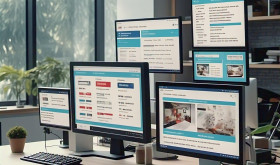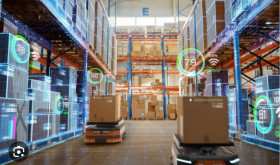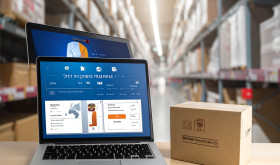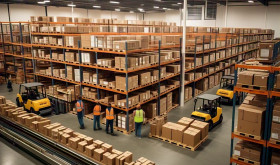
As shoppers continue to expect fast service, clear information, and convenience, tools like RFID and warehouse management systems go beyond basic functions. They now serve as key drivers of success in the retail world. Success in today’s competitive retail world depends on efficiency, accuracy, and keeping customers happy. Retailers must now juggle the growing demands of consumers while cutting costs and staying strong in their operations. The combination of Radio Frequency Identification (RFID) technology with modern warehouse management systems plays a huge role in this shift. This pairing is changing how retailers handle inventory, improve supply chains, and keep up with market needs.
Understanding RFID in Retail
Radio Frequency Identification (RFID) uses electromagnetic waves to identify and track tagged items. RFID works differently from barcodes since it does not need a direct line of sight, making it quicker and more precise for tracking products.
RFID tags hold data, and RFID readers can scan them at different checkpoints. Retailers use this to track inventory movement in real time, whether it’s in the warehouse or on the store shelves.
In retail, RFID is becoming popular because it helps:
- Make inventory tracking more accurate.
- Cut down on losses from theft or shrinkage.
- Speed up order fulfilment processes.
- Create smoother omnichannel shopping experiences.
Warehouse Management Systems in Retail
A warehouse management system refers to software built to handle warehouse tasks like receiving, picking, packing, shipping, and keeping track of inventory. Warehouse management systems play an important role in helping retailers oversee their stock well and ensure goods go from suppliers to distribution centres and then to customers without issues.
A warehouse management system handles several important tasks.
- It keeps track of inventory in real-time.
- It automates how orders are picked and packed.
- It helps organise storage to use space better.
- It works with transportation and order management systems.
- It provides reports and analytics to help make smarter choices.
The Power of RFID-Enabled Warehouse Management System
Adding RFID technology to a warehouse management system brings advantages that older barcode systems just can’t offer.
- Better Inventory Accuracy in Real Time
With RFID, a warehouse management system can track inventory with impressive precision often up to 99% accuracy. This greatly reduces errors and mismatches, helping make sure necessary products are always ready when needed.
- Quicker Receiving and Putaway
RFID tags on goods allow automatic scanning as they arrive at the warehouse. The system updates stock records right away, cutting down manual work and quickening the receiving workflow.
- Better Picking and Packing
RFID lets workers skip manual item-by-item scans. RFID readers find items on their own, lowering mistakes and making picking and packing faster.
- Less Shrinkage and Fewer Losses
Using RFID helps spot stolen or misplaced goods easily. Businesses can track how products move through the supply chain, which boosts accountability and reduces losses.
- Smoother Omnichannel Fulfillment
Shops now depend on seeing all their inventory in one place, whether it’s online, in-store, or through other sellers. Using RFID with a warehouse management system lets them view inventory updates in real-time. This helps them ship orders and serve customers better.
Case Study Examples
Fashion Retail
Clothing shops use RFID a lot to manage expensive items. Staff can scan the entire store’s stock with a handheld RFID device in a few minutes. Before, this would have taken hours. When it works with the warehouse management system, it helps restock faster and prevents running out of items.
Grocery Chains
Retailers selling fresh food rely on RFID-enabled warehouse management systems to track product movement along with expiration dates. Automated lot tracking helps them meet food safety rules and cuts down on waste by managing product rotation better.
E-Commerce Giants
Major e-commerce companies use RFID in cross-docking processes. Products arriving at warehouses get scanned, sorted, and dispatched without needing storage. This process slashes handling expenses.
Challenges in Implementation
Even though the advantages are clear, pairing RFID with a warehouse management system does come with its difficulties:
- Cost of Tags and Equipment: RFID tags and readers demand a bigger budget than barcodes even though their prices have dropped.
- Integrating Systems: Connecting RFID devices to systems like warehouse management systems and ERP needs careful planning and tech skills.
- Adapting to Change: Employees must learn new processes, so retailers need to train their teams for these updates to work.
- Too Much Data: RFID collects an overwhelming amount of information. Retailers need strong analytics tools to make sense of it and turn it into useful actions.
RFID and Warehouse Management System: Driving Sustainability in Retail
Besides improving efficiency, RFID-powered warehouse management systems support the push to be sustainable, which has become a major focus for retail.
- Less Waste: Improved visibility helps avoid overstock and spoilage with items that expire.
- Better Transport Planning: Having precise inventory info helps plan routes and loads more efficiently, which reduces carbon emissions.
- Boost to Circular Economy: RFID tracks product lifecycles, making it simpler to enable things like resale, recycling, and return logistics.
The Future of RFID and Warehouse Management System in Retail
In the future, RFID and warehouse management systems will deepen with other emerging technologies.
- AI and Machine Learning
AI will improve how businesses predict demand, assign inventory, and maintain RFID systems to prevent failures. - IoT Integration
Smart sensors will team up with RFID to track conditions such as temperature and humidity. This is important for storing items like fresh produce or medicine. - Blockchain to Ensure Traceability
Using blockchain with RFID will make supply chains more transparent and guard against tampering by creating secure records of products. - Robotics and Automation
Robots with RFID technology will manage tasks like picking and organising items on their own. This will cut costs for labour and make processes faster.
Conclusion
Integrating RFID technology with warehouse management systems is causing a big shift in retail supply chains. These systems give real-time tracking, make processes smoother, and improve shopping experiences. They help retailers handle today’s tough market better.
Even though there are still some obstacles, the rewards in terms of better efficiency, accuracy, and sustainability make the effort worth it. Retailers who adapt to this change will meet customer needs faster, save money, and create stronger supply chains that can handle the future.
As shoppers now expect faster service, more ease, and greater transparency, RFID and warehouses have become important drivers of success in retail.










